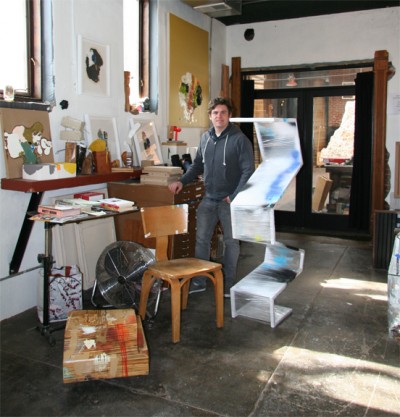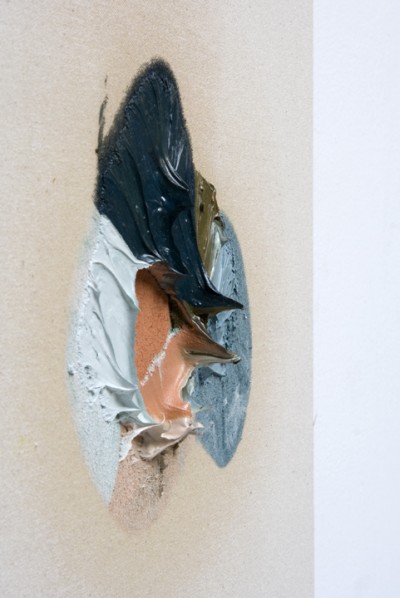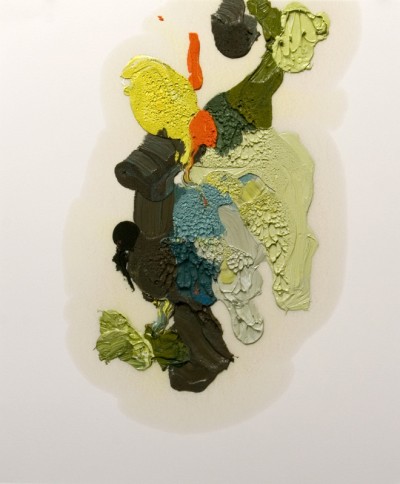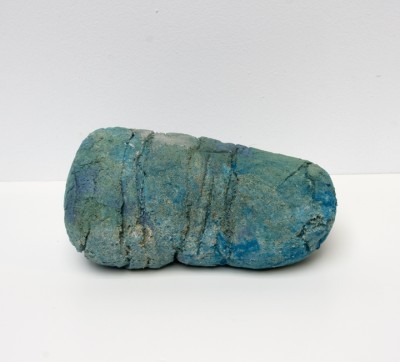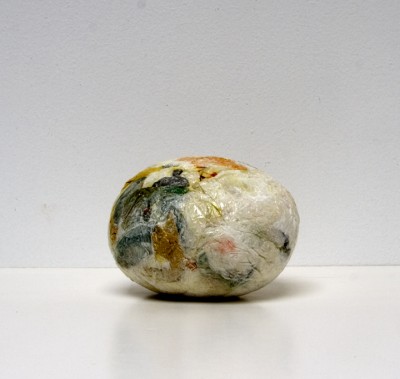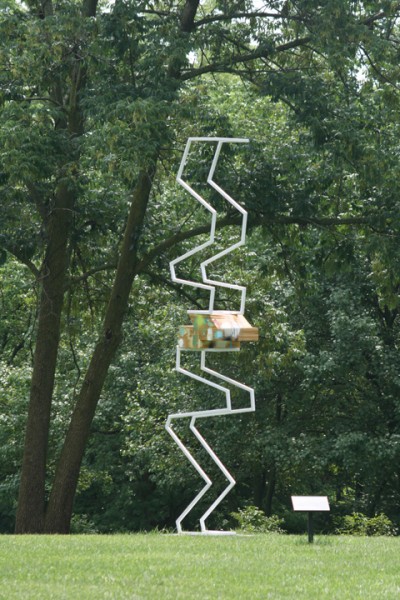Full disclosure: I have spent many happy hours in Brandon Anschultz‘s studio, located near Lafayette Square in St. Louis, MO, drinking wine, laughing hysterically at his sharp wit, and admiring his brilliant paintings and sculptures, which line the walls and fill every available corner and surface. Thus, this is a space which is near and dear to my heart. Anschultz is an exhaustive investigator of the raw materials of art-making. The essential qualities of paint, canvas, wood, and other basic materials–their internal physics, texture, tone, and hue–take center stage, becoming the primary subject of focus instead of merely serving as the means to an end. Over the past year or so, Anschultz has been utilizing a technique in which he applies layers of paint to two raw canvases (or sometimes canvas and paper) and then presses them together, leaving them to sit for days in their sticky embrace before separating them, the strata of color revealed and a jagged, mountainous topography created by the disengagement process. Simultaneous to these two-dimensional works, he has also been making small three-dimensional objects in which mixed, vivid colors are applied to wads of sawdust. Once dry, these turn into porous, geological formations reminiscent of volcanic rock. These have a charming, tactile quality, their simultaneously naturalistic qualities and completely unnatural color palatte exuding a certain humor.
In the five years that I have known Anschultz, he has been constantly busy traveling around the country to participate in exhibitions. Since finishing his MFA at Washington University in St. Louis in 2002, he has shown in a host of galleries, alternative spaces and museums, in cities from Pullman, WA to Philadelphia and from New Orleans to Chicago. This past fall, his solo exhibition, Stick Around For Joy, was first shown at Laumeier Sculpture Park in St. Louis and then traveled to Longue Vue House and Garden in New Orleans, a historical home which has recently begun to exhibit contemporary art within the context of the preserved residential space. Also, in January he participated in a two person show at Tiger Strikes Asteroid in Philadelphia titled Due Diligence Done. In the next few months, he will open a show at The Hills in Chicago, and then spend the summer as an artist-in-residence at Cite Internationale des Artes in Paris.
Elizabeth Wolfson: What do you consider the primary concerns of your practice? What questions are you asking, either of yourself or your work? What results are you most interested in?
Brandon Anschultz: I’m asking formal questions about painting, about sculpture, about abstraction, and the act of making in general. I also think a lot about the longevity of objects and what’s specific about the moment in which they’re created. Everything is so speedy in life, I want the work to slow that down a bit. Making something that takes months and months to reach a point of stability, yet which hurdles through time in a non-stable way. I’m asking personal questions, too, but they’re less relevant. I’m most interested when the work reaches a quizzical balance or imbalance.

After years of making abstract paintings and sculptures with a narrative backbone, I decided at some point last year to remove that content, which resulted in my striving to remove my hand even further from the end result. I started to make what are literally “mash-up paintings,” where the pressure of the two surfaces made many of the aesthetic “decisions.” It seems like a really honest way for me to produce. For instance, in these two paintings, (PK On Canvas and PK on Paper), one of which is on canvas and the other on paper, I determined the color strategy–murky greens and blues, acidic yellows and intense straight-out-of-the-tube cadmium red–and intuitively applied the oil paint to the paper and pressed a prepared raw canvas on top. After a week or two pressed together, I separated them. Much of the oil leached out of the paint into the paper and the canvas texture pressed into the paint remaining. These aren’t stable, archival object; the paper and raw canvas will continue to degrade and change with time. The work becomes more of a strategy and a stain.
At the same time that I’m making these paintings, I have another strategy or process going where the colors are mixed and added less discriminately to piles of sawdust and formed into wads. These dry and crack and change with time, not unlike geological formations (geodes, etc.).
I also try to use every part of the process, if possible. For instance, the vinyl gloves I used handling paint are then compressed with glue to create a third byproduct of the process, these really beautiful wads.
EW: You produce a diverse range of objects, both two- and three-dimensional. How do these different ways of working fit together or compliment each other?
BA: They totally fit together in my strategy for production as well as their inherent materiality. I’ve always made work that loops in on itself, either for context or reference. For instance, the piece Arkansas Math, which I showed outside at both Laumeier Sculpture Park and Longue Vue, originated from a video I made about eight years ago called Dot on the Move. It was a really short and spare music video that traced an invisible map of the places that I’ve spent most of my life–Arkansas, Louisiana, Missouri. The viewer would likely never realize this, as it’s basically a felt dot on a wire moving against a white background. I retraced the video from memory and used it as the point of departure for the form of Arkansas Math, an 11’ tall zig-zaggy metal structure with a wooden center point. The parts from that sculpture are now back in the studio and I’ve been experimenting with different versions, wrapping one of the pieces in plastic and painting on it while I’ve made a khaki sleeve to cover the other. I also have some footage that I’ll be using to make a video, taking the piece back to the older Dot on the Move territory.
EW: Can you describe your current primary way(s) of working/process(es)? How has this process evolved over time?
BA: I make works in fits of processes. It’s a pretty organized. I decide on materials and strategy, do all the necessary prep work, building panels or canvases with a specific purpose in mind. I usually get distracted pretty quickly and loose my initial intention after one or two attempts. I like to make things quickly, putting a lot of energy into the build-up and then making a fairly spontaneous “mark” within whatever parameters I’ve decided upon. Then, there’s usually an element of time, where I leave something to “cook” for a while.
EW: In talking about your practice, you’ve mentioned “frustration” and “tediousness” as both rewarding and exasperating aspects of your practice. Can you elaborate on this duality? What constructive contributions do frustration and tediousness make to your experience making art and the works that you produce?
BA: I think for a long time I viewed the “frustrated searching” in my studio practice as a negative and was always looking for a solution. I’ve realized in the last couple of years that the searching is the reward. This might sound very simple and obvious, but it was something that I really missed in assessing myself.
I always want to be moving forward within my work, making the next discovery. I get bored really quickly and want the next innovation. In some ways this is good, because I’m most always excited about working in the studio, but it can also inhibit the process of fleshing out an idea. I’ve made a conscious effort to slow down my rate of change in the studio and more deeply investigate the processes that I started last year.
EW: You’ve also mention the travel opportunities and social experiences that your practice has provided as another rewarding aspects of your work. Can you list a couple of highlights thus far that stand out in your mind?
BA: I got to work last year at a really interesting place in New Orleans called Longue Vue House and Garden. It’s a really odd place (in an already eccentric city). I got to interject my work into a “frozen in time” mansion and grounds. I had some pretty interesting interactions with the docents there who feel a real ownership of the place and were pretty visibly bothered (in a very genteel way) by my intrusion into their world. It was an interesting negotiation of expectations, on both our parts, one that was hopefully rewarding to all involved.
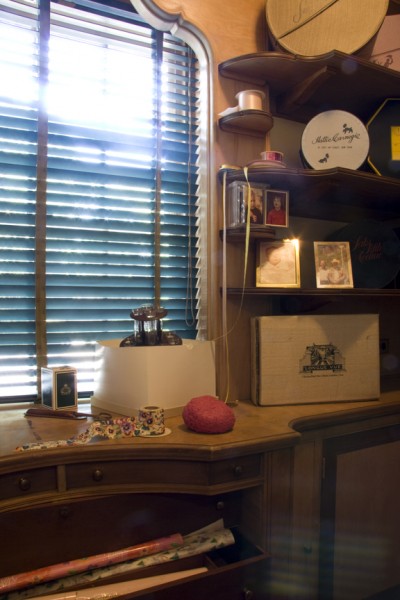
Brandon Anschultz, "The Brain," oil paint and sawdust, 2010. Installation shot from "Stick Around For Joy" at Longue Vue House and Garden, 2010.
EW: Do you see evidence in the evolution of your work that indicates you’ve been influenced by your travel experiences, that you’ve absorbed (either consciously or unconsciously) new ideas or information that have redirected your practice?
BA: I think every experience brings something back to the studio, it’s unavoidable. I was at the ACRE (Artists Cooperative Residency and Exhibitions) residency last summer in Wisconsin and found some random scraps of wood that then became the substrate for a few paintings, transforming them significantly. On the same trip, I used screen-printing for the first time, making screens directly from the residual plastic material I was using to make paintings at the time. The screen-prints then became these little paper sculptures. The byproduct of that, though, was my renewed interest in making paintings on paper.
After working on raw canvas for the last year or so, moving to paper has been really interesting. I use smooth Bristol, which has very little texture and remains very flat and absorbs the oil from paint in a really nice way. It’s prompted me to explore other extremely porous materials. For instance I’ve been using raw MDF (medium density fiberboard) and applying paint directly to the surface. It makes these really nice halos around the paint as the MDF leaches the oil out of the paint. I’m not really sure what’s going to happen to these pieces as they continue to change with time.
EW: Though it’s still several months away and I realize it might be too early to make projections, do you have any thoughts at this point regarding what you hope to accomplish during your residency in Paris this summer, and how you’re hoping it will impact your current practice? Do you feel the relocation will force you to work in new ways or consider your work from a new perspective?
BA: I hope so, I’m going into it without a real agenda. I’m going to set up some loose goals and parameters for myself, but really allow the experience to dictate what I produce. I’m trying to decide whether to take some materials with me or to explore and use what I find there.

